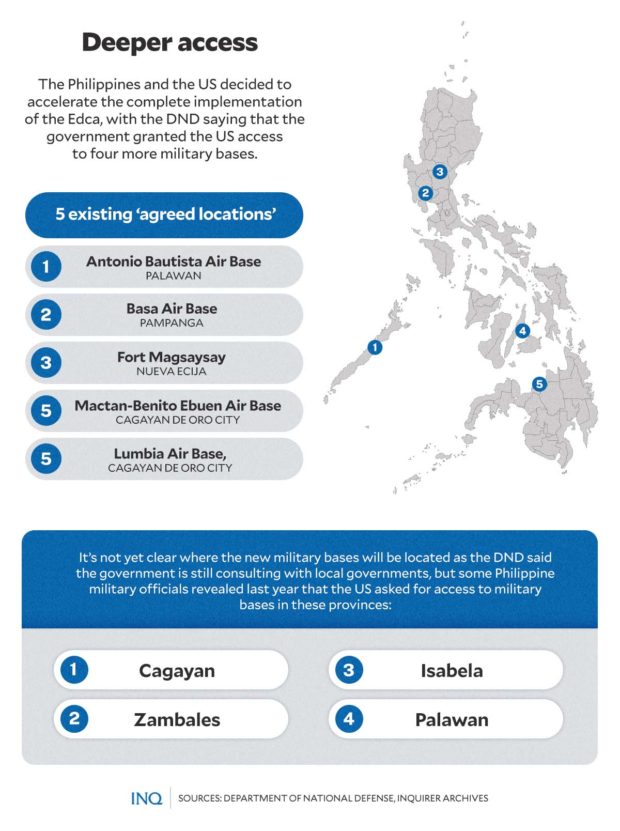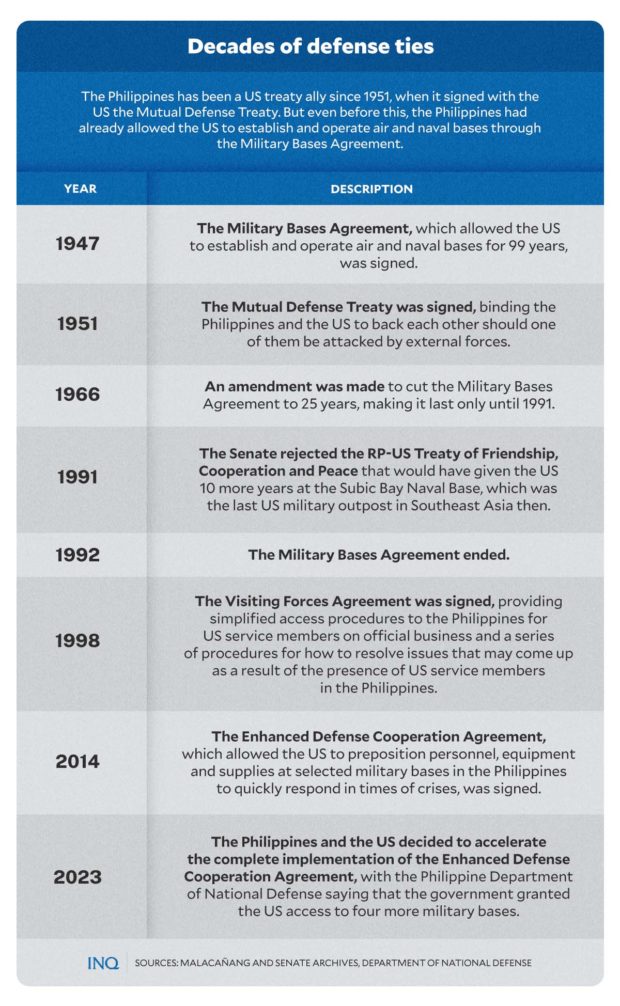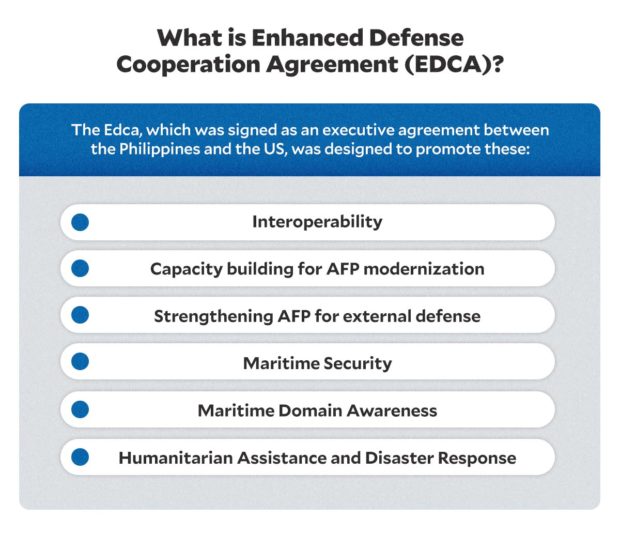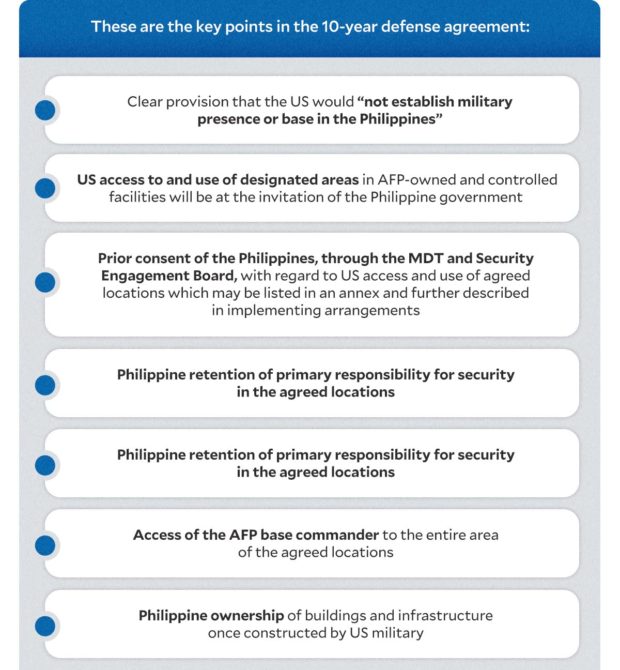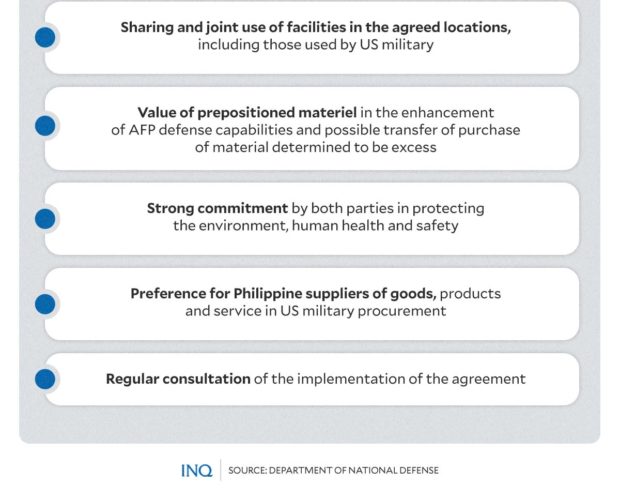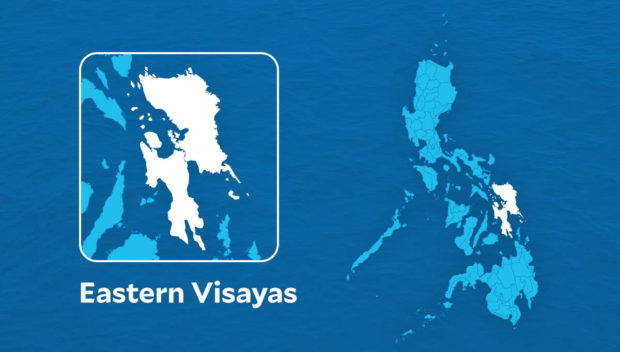Posted to the Stars & Stripes (Feb 17, 2023): Lawmakers eye opportunities as Philippines base access expands (By BRIANA REILLY//CQ-ROLL CALL)
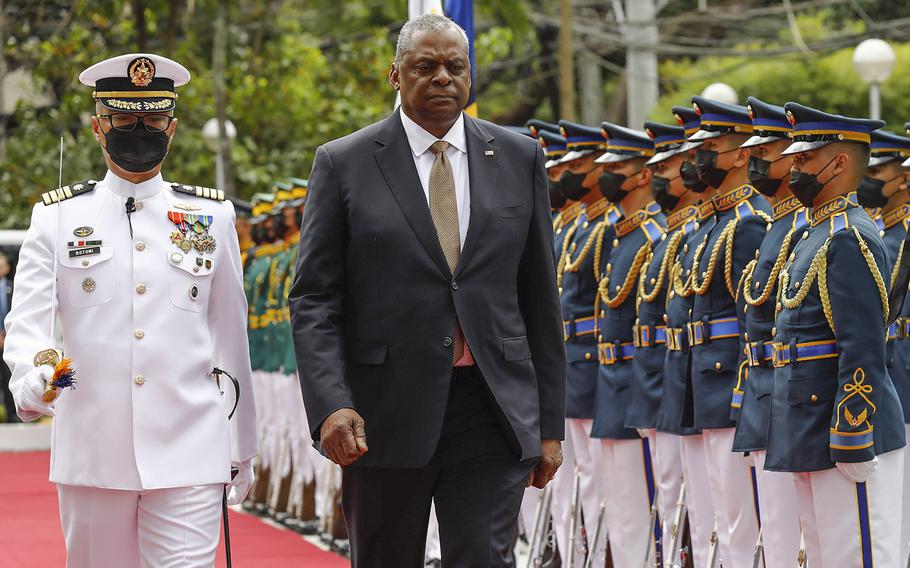 United States Defense Secretary Lloyd Austin, right, walks past military guards during arrival honors at the Department of National Defense in Camp Aguinaldo military camp on Feb. 2, 2023, in Quezon City, Manila, Philippines. (Rolex Delapena, Pool/Getty Images/TNS)
United States Defense Secretary Lloyd Austin, right, walks past military guards during arrival honors at the Department of National Defense in Camp Aguinaldo military camp on Feb. 2, 2023, in Quezon City, Manila, Philippines. (Rolex Delapena, Pool/Getty Images/TNS)WASHINGTON (Tribune News Service) — Lawmakers say the Pentagon's newly unlocked access to a handful of additional bases in the Philippines will boost the United States' ability to deter Chinese aggression while deepening collaboration with a key ally in the region.
While it remains to be seen what kinds of investments those four new sites in the Philippines — on top of the five existing ones established under the Enhanced Defense Cooperation Agreement — will need to ensure they're leveraged to their full potential, one House Armed Services member expects to see "strong bipartisan support" for funding in that area.
"In some ways, the heightened realization that China's not fooling around with the surveillance balloon really will help the momentum for the Philippines decision," Rep. Joe Courtney, D-Conn., said in an interview Thursday.
In addition to enhancing DOD's strategic posture in the Indo-Pacific, the news, announced earlier this month during Defense Secretary Lloyd J. Austin III's trip to the Philippines, supports a broader military shift toward bolstering the resiliency of current bases while distributing forces across multiple sites, making them harder to target.
Calling the Philippines "the point of the spear in the South China Sea," Adm. Harry B. Harris Jr., the former head of U.S. Pacific Command (which has since been renamed U.S. Indo-Pacific Command) and a former ambassador to South Korea, underscored the importance of the expanded site access in the so-called first island chain during the House Armed Services Committee's inaugural hearing of the new Congress last week.
"It's hard to imagine a fight with the [People's Republic of China] without being able to use bases on the Philippines," he said.
Slow buildup
Under the Enhanced Defense Cooperation Agreement, inked in 2014, the Philippines allowed for an increased rotation of U.S. troops, aircraft and ships in its territory. But progress under the deal was slowed under former Philippines President Rodrigo Duterte's administration, which spanned 2016 to 2022.
The first five sites were announced in 2016, and the first major project — a humanitarian assistance and disaster relief warehouse — began two years after that. Those five existing bases have received more than $82 million in U.S. infrastructure investments, according to DOD's announcement Feb. 1.
Specifically, media reports from November show the U.S. committed to spending $66.5 million on training and warehouse facilities at three of those bases, with construction to start this year.
Going forward, DOD's release states that the U.S. and Philippines "have committed to move quickly in agreeing to the necessary plans and investments for the new and existing EDCA locations," though it doesn't commit to a timeline. DOD also hasn't yet disclosed the locations of the four new sites, but the announcement said they "will allow more rapid support for humanitarian and climate-related disasters in the Philippines" while responding "to other shared challenges."
Stacie Pettyjohn, a senior fellow and defense program director at the think tank Center for a New American Security, wrote in an email that significant upgrades are needed at the sites to support U.S. operations. While she commended the investments in warehouses, noting many of the supplies needed for disaster relief "are dual purpose," meaning also applicable for military use cases, she said "there is still much to be done to 'operationalize' the bases."
She pointed to boosting existing airfields with runways that she said are often too short or "not made of sufficiently strong concrete to support heavy American aircraft." She also called for additional parking ramps to allow base forces to spread out, reinforced headquarters buildings, redundant fuel tanks and pumps, heavy rapid runway repair equipment and decoys or other materials to camouflage, conceal or deceive adversaries, among other things.
These efforts would improve the survivability of U.S. military assets in the event of an attack.
"I think that there is considerable support for PDI among lawmakers and countering China, but less support for overseas military construction projects and less sexy logistics and support equipment that is needed to enable American military operations while under attack," she said, referring to the collection of DOD regional investments known as the Pacific Deterrence Initiative. "Historically, members of Congress don't like military construction dollars going overseas."
Courtney, however, signaled he's optimistic that lawmakers will rally behind Enhanced Defense Cooperation Agreement funding. He noted the investments lawmakers authorized and appropriated in fiscal 2023 in support of the Pentagon's various planned construction investments for northern Australia, totaling just over $500 million over the next five years. For example, members authorized and appropriated a $72.4 million Navy project at Royal Australian Air Force Base Darwin for an aircraft parking apron.
"Again, we have a big House of Representatives and lots of different perspectives that are reflected there, but I think that the Australian example, combined with China's behavior is going to, I think, really provide a lot of ballast for an initiative like the Philippine EDCA to move forward," he said.
Strategic importanceWhile lawmakers on the House and Senate Armed Services readiness subcommittees, which oversee military construction, didn't weigh in on funding specifics, members who provided comment on the announcement voiced support for expanded site access — particularly as a means of countering China.
"Enhanced defense cooperation between the United States and the Philippines is a credible deterrent against Communist Chinese aggression," Rep. Austin Scott, R-Ga., said in a statement earlier this month. "The Philippines are one of our oldest allies in the region, and these new measures are a win-win for both countries."
The 2014 Enhanced Defense Cooperation Agreement, and the current U.S.-Philippines defense relationship, has its roots in a mutual defense treaty that dates back to 1951, established in the years after the Philippines gained independence following decades as a U.S. territory. This month, in addition to announcing the expanded site access, both countries have agreed to resume joint maritime patrols in the South China Sea.
Meanwhile, Rep. John Garamendi, the ranking member of the readiness panel, noted the news from Austin's Philippines trip "will strengthen that alliance while developing coordination and cooperation between our militaries."
"It is important to look at China's illegal fishing practices and the development of bases throughout the South China Sea," the California Democrat added in a statement.
On the Senate side, Sen. Mazie K. Hirono, D-Hawaii, said in a statement Thursday that lawmakers' efforts in the region shouldn't be limited to military construction, though she acknowledged that work is "key" to maximizing the agreement in benefit of allied parties in the region.
She added that she will find chances to "prioritize infrastructure improvements in the Pacific" and Hawaii as chair of the Senate Armed Services readiness subcommittee. She said she'll be watching for DOD to include infrastructure projects in both the fiscal 2024 budget request and Pacific Deterrence Initiative.
"Our construction efforts should focus on dual use facilities that benefit the DOD and the host nations with a focus on the issues they care about, including climate change, illegal fishing, and disaster preparation," she said.
Any movement this Congress on Philippines base funding comes on top of the military services' efforts to prioritize resilience in their force and capability distribution. That includes the Marine Corps' efforts under Commandant Gen. David Berger to overhaul its force design approach in the Indo-Pacific this decade to allow for an agile, forward presence in the region.
Beyond that, the Air Force has included resilient basing among its recently released operational priorities that Secretary Frank Kendall says are critical for deterring adversaries including China and repositioning the service for the future. Asked about that priority in relation to the expanded basing announcement, Air Force Chief of Staff Gen. Charles "CQ" Brown said during a Brookings Institution event Monday that the imperative shapes how officials pre-position basic capabilities, but that for the most part those capabilities are "location-agnostic."
Still, Brown, who previously served as Pacific Air Forces commander, noted the news "provides additional opportunities for access" as officials look at resource distribution.
When considering other sites in the region, Pettyjohn noted that lawmakers' attention is often trained on active missile defenses for Guam, investments she said "are definitely needed, but alone are not sufficient for dealing with the problem."
Alaska Republican Dan Sullivan, the ranking member of the Senate Armed Services readiness subcommittee, which oversees military construction, said in a brief interview Wednesday that he's raised concerns that "Guam is becoming highly concentrated" in terms of military buildup.
"Surging forces in the INDOPACOM region — you can't put everything on Guam," he said, referencing the Indo-Pacific Command area of operations as he made the case for boosting the DOD footprint in Alaska.
"Alaska's in the INDOPACOM and a lot of the time, you don't have people who think that, who know it," he added. "We have to distribute forces, so the Philippines, yes, Alaska, yes, and Guam, not so highly concentrated."
https://www.stripes.com/theaters/asia_pacific/2023-02-17/lawmakers-opportunities-philippines-base-access-china-9177005.html
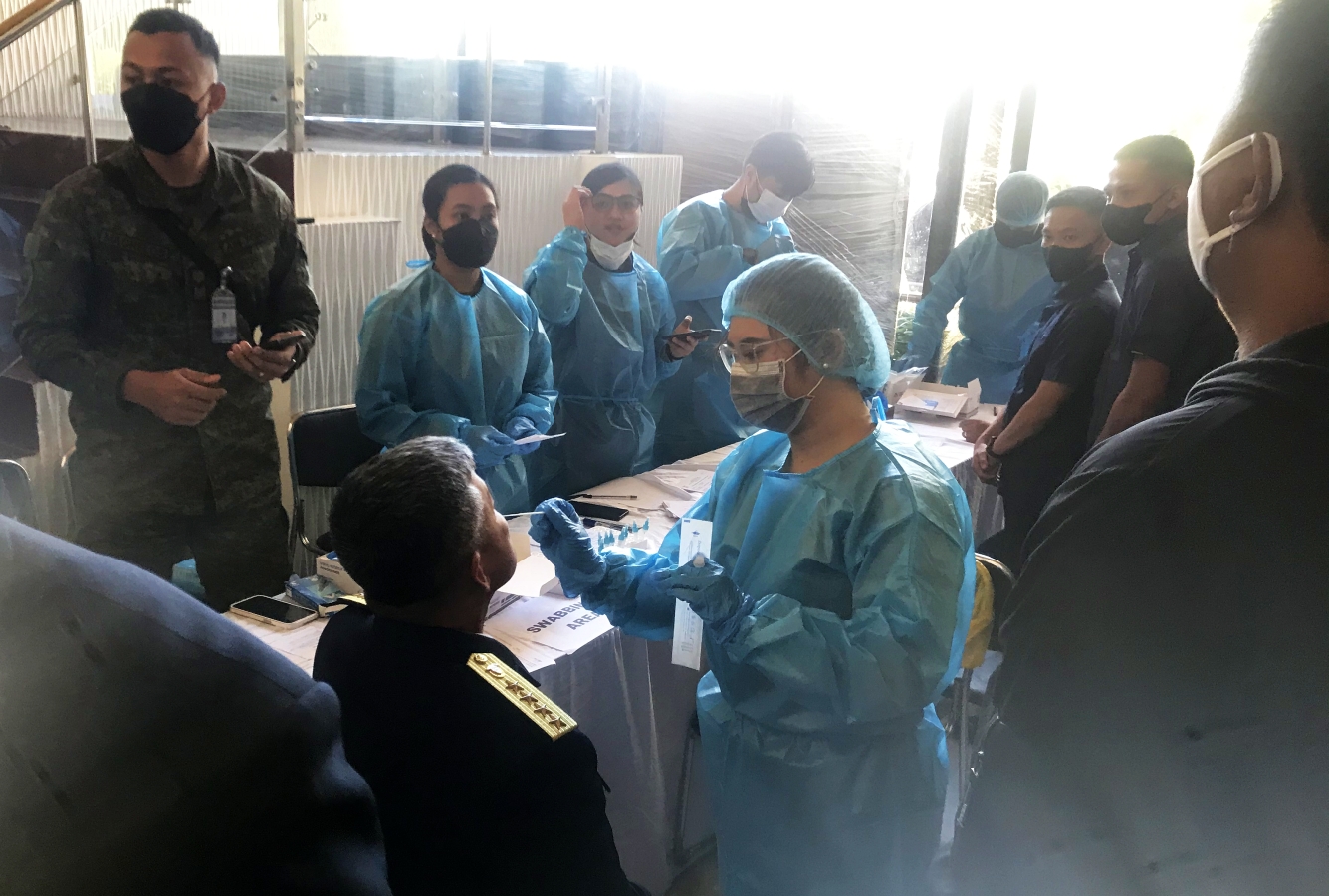






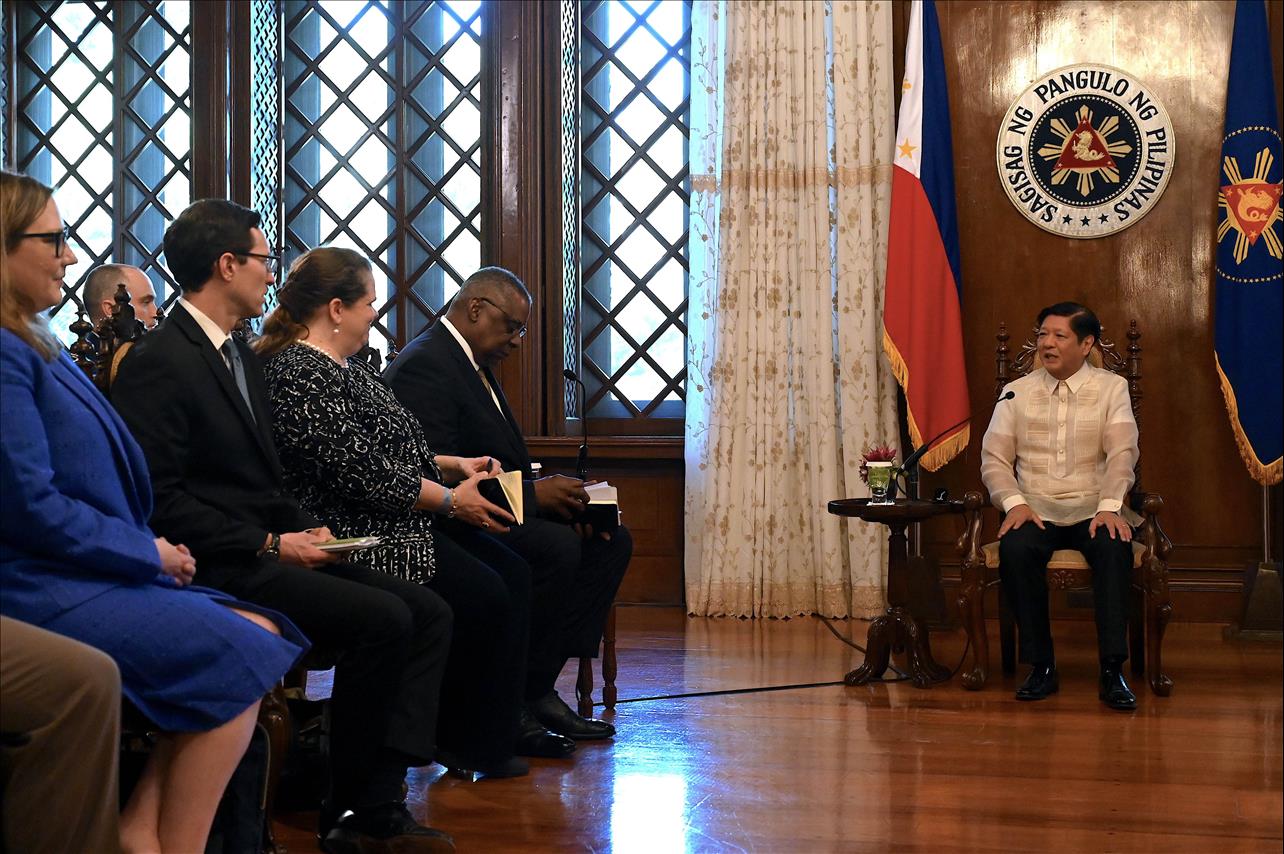


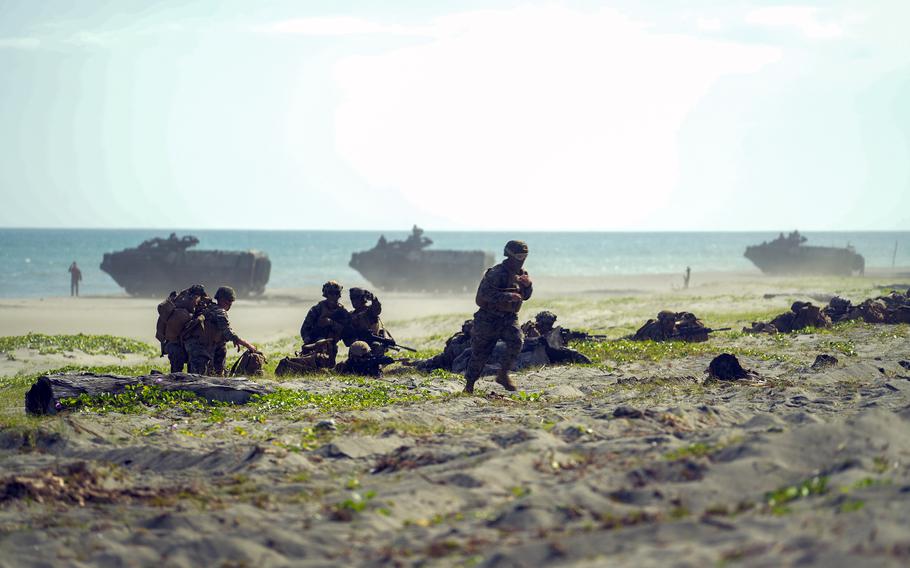
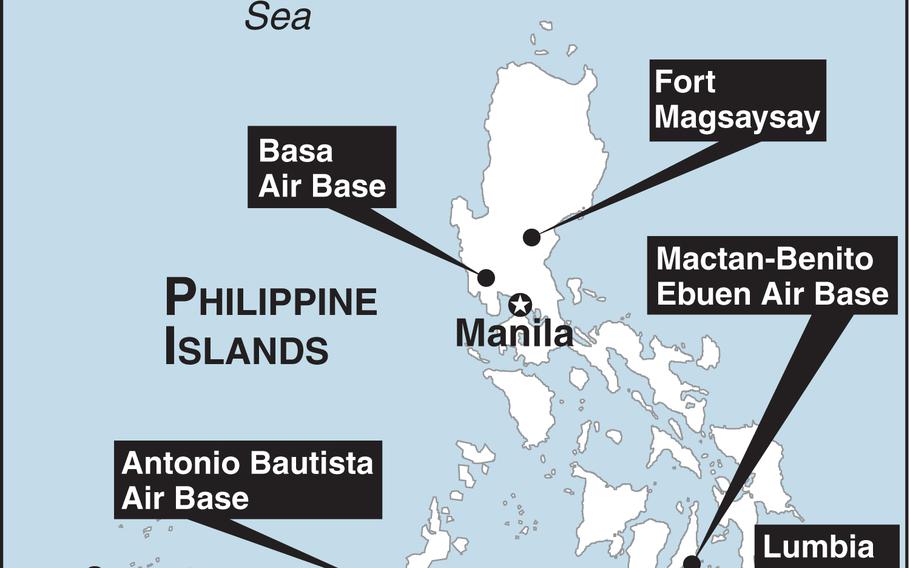
:quality(70)/cloudfront-eu-central-1.images.arcpublishing.com/thenational/H2CMKGW6O47SQZ5KT7FLBQKGSE.jpg)
:quality(70)/cloudfront-eu-central-1.images.arcpublishing.com/thenational/SL53PPZ6TAOBF3UTJJPWT4V654.jpg)
:quality(70)/cloudfront-eu-central-1.images.arcpublishing.com/thenational/ACDO7OD7NLQPHR5YPX7YXZO7RE.jpg)
:quality(70)/cloudfront-eu-central-1.images.arcpublishing.com/thenational/E72QYK5RAMGZ7HRTWGAYF6YWQM.jpg)
:quality(70)/cloudfront-eu-central-1.images.arcpublishing.com/thenational/7WHIFIPMDQFA35V3M3WMAKBGRM.jpg)


